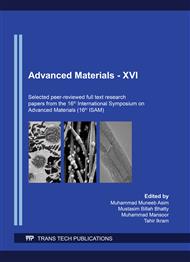[1]
S.V. S. N. Murty, A. Sarkar, P.R. Narayanan, P.V. Venkitakrishnan, J. Mukhopadhyay, Microstructure and micro-texture evolution during large strain deformation of aluminium alloy AA 2219, Mater. Sci. Eng. A 677 (2016) 41–49.
DOI: 10.1016/j.msea.2016.09.027
Google Scholar
[2]
J. Zhang, B. Chen, Z. Baoxiang, Effect of initial microstructure on the hot compression deformation behavior of a 2219 aluminum alloy, Mater. Des. 34 (2012) 15–21.
DOI: 10.1016/j.matdes.2011.07.061
Google Scholar
[3]
F. Zhou, C.-M.Suh, S.-S. Kim, R. Murakami, Sliding-wear behavior of TiN- and CrN-coated 2024 aluminum alloy against an Al2O3 ball, Tribol. Lett. 13(2002) 173–178.
Google Scholar
[4]
M. I. Bashir et al., Enhanced surface properties of aluminum by PVD-TiN coating combined with cathodic cage plasma nitriding, Surf. Coat. Technol. 327 (2017) 59–65.
DOI: 10.1016/j.surfcoat.2017.08.015
Google Scholar
[5]
S. Gredelj, S. Kumar, A.R. Gerson, G. P. Cavallaro, Radio frequency plasma nitriding of aluminium at higher power levels, Thin Solid Films 515(2006) 1480–1485.
DOI: 10.1016/j.tsf.2006.04.031
Google Scholar
[6]
A. Yazdani, A. Zakeri, An insight into formation of nanostructured coatings on metallic substrates by planetary ball milling, Powd. Technol. 278(2015) 196–203.
DOI: 10.1016/j.powtec.2015.03.026
Google Scholar
[7]
C. Liu, A. Leyland, Q. Bi, A. Matthews, Corrosion resistance of multi-layered plasma-assisted physical vapour deposition TiN and CrN coatings, Surf. Coat. Technol. 141(2001) 164–173.
DOI: 10.1016/s0257-8972(01)01267-1
Google Scholar
[8]
A. Wilson, A. Matthews, J. Housden, R. Turner, B. Garside,A comparison of the wear and fatigue properties of plasma-assisted physicalvapour deposition TiN, CrN and duplex coatings on Ti-6Al-4V,Surf. Coat. Technol. 62(1993)600–607.
DOI: 10.1016/0257-8972(93)90306-9
Google Scholar
[9]
M. I. Bashir et al., Enhanced surface properties of aluminum by PVD-TiN coating combined with cathodic cage plasma nitriding, Surf. Coat. Technol. 327(2017)59–65.
DOI: 10.1016/j.surfcoat.2017.08.015
Google Scholar
[10]
S. MishraV. Yadava, Laser Beam Micro Machining (LBMM) – A review, Opt. Lasers Eng.73(2015) 89–122.
Google Scholar
[11]
T. Hu, L. Hu, Q. Ding, Effective solution for the tribological problems of Ti-6Al-4V: Combination of laser surface texturing and solid lubricant film, Surf. Coat. Technol. 206(2012) 5060–5066.
DOI: 10.1016/j.surfcoat.2012.06.014
Google Scholar
[12]
L. Rapoport et al., Friction and wear of MoS2 films on laser textured steel surfaces, Surf. Coat. Technol. 202(2008) 3332–3340.
DOI: 10.1016/j.surfcoat.2007.12.009
Google Scholar
[13]
M.P. AnanthR. Ramesh,Sliding wear characteristics of solid lubricant coating on titanium alloy surface modified by laser texturing and ternary hard coatings,Trans. Nonferrous Met. Soc. China 27 (2017) 839–847.
DOI: 10.1016/s1003-6326(17)60096-7
Google Scholar
[14]
G.D. Gautam, A.K. Pandey, Pulsed Nd:YAG laser beam drilling: A review, Opt. Laser Technol. 100 (2018) 183–215.
DOI: 10.1016/j.optlastec.2017.09.054
Google Scholar
[15]
N. Mohan, C.R. Mahesha, B.M. Rajaprakash, Erosive Wear Behaviour of WC Filled Glass Epoxy Composites, Procedia Eng. 68 (2013) 694–702.
DOI: 10.1016/j.proeng.2013.12.241
Google Scholar
[16]
B. JönssonS. Hogmark, Hardness measurements of thin films, Thin Solid Films 114 (1984) 257–269.
DOI: 10.1016/0040-6090(84)90123-8
Google Scholar
[17]
W. SteenJ. Mazumder, Laser Material Processing, 4th ed. London: Springer-Verlag, (2010).
Google Scholar
[18]
T.V. Kononenko et al., Laser ablation and micropatterning of thin TiN coatings, Appl. Phys. A71 (2000) 627–631.
Google Scholar
[19]
N. Morshedian,Specifications of nanosecond laser ablation with solid targets, aluminum, silicon rubber, and polymethyl methacrylate (PMMA), Plasma Sci. Technol. 19 (2017) 095501.
DOI: 10.1088/2058-6272/aa74c5
Google Scholar
[20]
J. van den Brand, S. Van Gils, P.C. J. Beentjes, H. Terryn, V. Sivel, J.H. W. de Wit,Improving the adhesion between epoxy coatings and aluminum substrates, Prog. Org. Coat. 51 (2004) 339–350.
DOI: 10.1016/j.porgcoat.2004.08.005
Google Scholar


